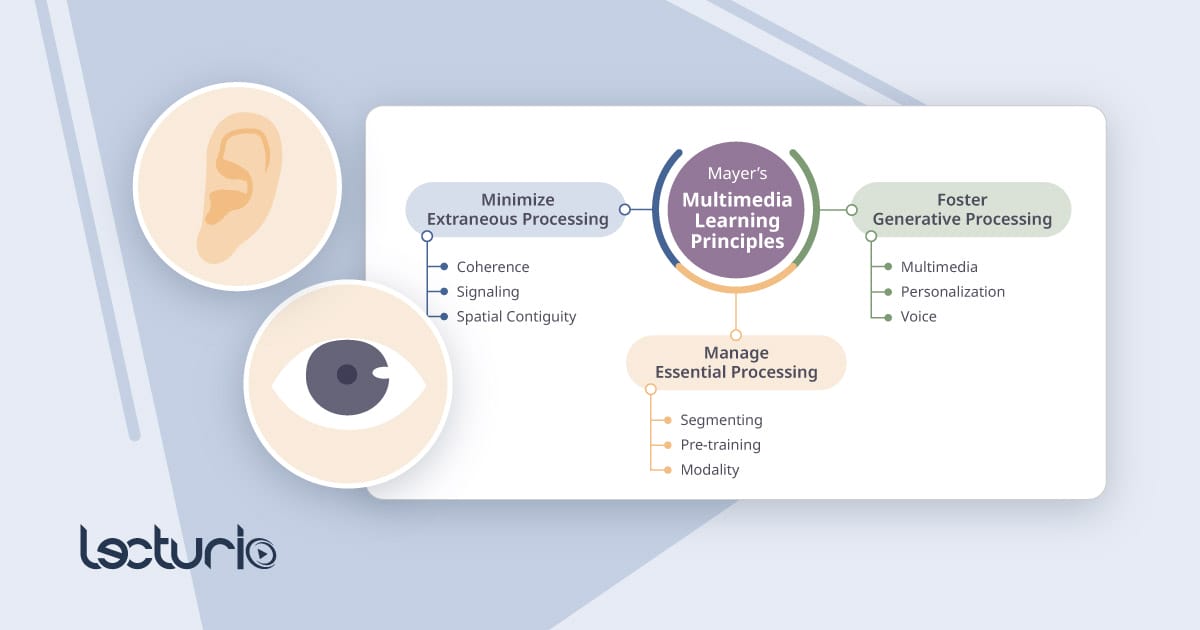Mayer’s evidence-based framework—built on the dual-channel, limited capacity, and active processing principles—underpins effective multimedia learning. At Lecturio, these principles guide our video lessons, graphics, quizzes, and supplementary resources. Here’s how:
1. Reducing Extraneous Processing
Principles: Coherence, Signaling, Spatial Contiguity (Lecturio)
- Lecturio videos feature streamlined visuals: only essential anatomical structures are shown—no distracting clip art or irrelevant backgrounds.
- When highlighting features (e.g., heart valves), we spotlight them through animation, color, or zoom—echoing the signaling principle.
- Diagrams and labels are deliberately positioned together, ensuring learners don’t strain their working memory—faithful to the spatial contiguity rule.
2. Managing Essential Processing
Principles: Pre-training, Segmenting, Modality (Lecturio)
- Lecturio’s “Concept Prep” animations introduce specialist terminology and visual cues before diving into core content—supporting the pre-training principle.
- Videos are carefully segmented into short, learner-controlled modules—aligning with the segmenting principle.
- Narration replaces on-screen text wherever possible. Key points may still appear visually, but learning is driven by spoken explanation, in line with the modality principle.
3. Fostering Generative Processing
Principles: Multimedia, Personalization, Voice (Lecturio)
- Every concept pairs voice-over narration with dynamic visuals, not text-only slides—directly applying the multimedia principle.
- The conversational tone (“Let’s take a look…”) makes content more relatable, reflecting the personalization principle.
- Lecturio uses human voice narration, not synthetic voiceovers—honoring Mayer’s voice principle while enhancing engagement.
4. Additional Mayer-Inspired Principles
Principles: Temporal Contiguity, Redundancy, Embodiment (Lecturio)
- Narration and animation are synchronized: diagrams change exactly as explanations evolve—supporting temporal contiguity.
- Transcripts or captions accompany speech without duplicating it on-screen—avoiding the redundancy effect.
- Many videos feature instructors drawing live or using gesture emphasis, demonstrating the embodiment principle and fostering a human connection.
5. Interactive & Accessible Design
- Built‑in quizzes, reflection pauses, and dynamic question prompts encourage active processing, helping learners summarize and self test—an embodiment of Mayer’s generative activity principle (Lecturio).
- Captions, transcripts, and adjustable playback speeds ensure accessibility and universal design—critical in maximizing learning for all.
6. Graphic Design & Universal Design
In support of cognitive load reduction:
- Lecturio ensures clear legible fonts, high-contrast graphic styles, and simplicity suited for mobile viewing—embedding foundational graphic design principles (Lecturio).
- The platform’s interface integrates Quality Matters‑inspired navigation: course maps, progress tracking, downloadable assets—helping learners focus on understanding, not navigation.
Real-World Benefits for Learners & Educators
| Audience | Benefit |
| Learners | • Retain more through coordinated visuals & audio• Learn actively via embedded quizzes• Access anytime with increased autonomy & flexibility |
| Educators | • Reuse polished, pedagogically sound content• Replace long lectures with dynamic prerecorded modules• Focus live sessions on discussion, case studies, or active learning |
Summary
Lecturio’s video content and complementary resources are purposefully designed through the lens of Mayer’s multimedia principles. By reducing unnecessary load, structuring essential concepts effectively, fostering active meaning-making, and embedding accessibility and engagement—Lecturio offers a rich, evidence-based learning ecosystem. That means content like clear animations, human narration, quizzes, and interactive segments aren’t just features—they’re intentional strategies rooted in cognitive science.
Ready to enhance your curriculum? Dive into Lecturio’s video library with confidence—knowing each element supports Mayer’s proven path to better learning.

